If you are joining the marching band and already play the saxophone, or if you possibly play a different instrument and are considering switching to the saxophone, you may have questions before getting started. We hope this article can help answer those questions!
Saxophones in marching bands are no different than saxophones played in concert ensembles, although because players will be playing the saxophone outside in different weather they need to carefully choose which instrument will work well in an outdoor setting.

Are there Saxophones in Marching Band?
Yes, many marching bands include saxophones. The most commonly used saxophones in marching bands are alto and tenor saxophone. Other marching bands may use baritone saxophone, but this is more uncommon.
Many marching bands in public school systems and colleges do use saxophones.
You will not see saxophones, or any woodwinds for that matter, in a drum and bugle corps such as Drum Corps International (DCI). This high-caliber organization focuses exclusively on brass, percussion, and color guard, without including any woodwind instruments.
If you do play saxophone and you want to participate in DCI, you will need to learn brass or percussion, or color guard. Many woodwind players do this and are still able to participate.
Top Tip: Learn what other instruments are part of the marching band by reading this article: Instruments in a Marching Band (How Many & What Kind)
What Type of Saxophone is in Marching Band?
The most common types of saxophones used in marching bands are the alto saxophone and the tenor saxophone. Other saxophones may appear in marching bands at times but are more uncommon.
Soprano Saxophones
Soprano Saxophones are fairly common in the music world, but these instruments are not typically played in marching bands unless there is a specific featured soloist.
If soprano saxophone is used, you will not see a large section of soprano saxophones like you will with alto or tenor. Soprano saxophones are higher in pitch and would not blend well in a marching band setting.
Alto Saxophones
Alto Saxophones are the most common saxophones seen in marching bands. Alto saxophones can play in a wide range of pitches, but most of the time, they fill in the middle range of the band.
Alto saxes will most commonly match mellophone parts but they can also play with lower clarinets, trumpets, or other instruments in that range.
Alto saxophones will not be able to match the high register of the flute or the low range of trombones, baritones, euphoniums, or tubas.
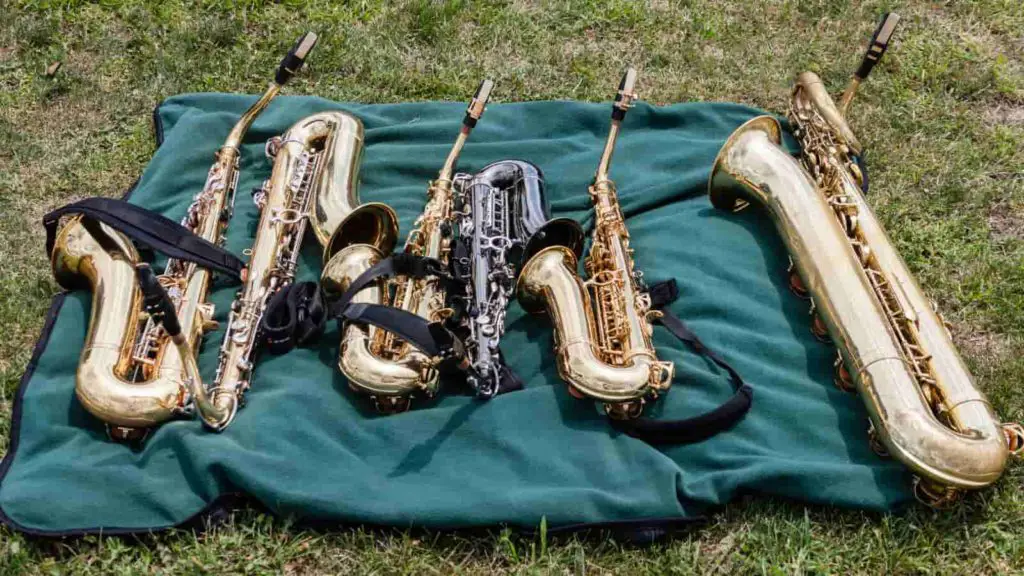
Tenor saxophones
Tenor saxophones are larger than alto saxophones and can play in a lower range. Tenor saxophones typically match the trombones, baritones, and euphoniums.
They can also play in a wide range and often get interesting parts. Tenor has the flexibility of playing low parts while keeping the dexterity needed for faster woodwind parts.
Baritone Saxophones
Baritone Saxophones are the largest saxophone seen in marching bands, and not used in every marching band. They are very large, heavier than the other saxophones, and can produce a very low sound.
Most marching bands rely on low brass instruments to cover this range of the ensemble, but when directors have trouble filling in low brass instruments, sometimes, students play baritone saxophone.
🎵 Trivia: Can you guess how many different types of Saxophones there are? Click here to see if you are right!
How and Where to Buy a Saxophone for Marching Band
If you need to purchase a saxophone to use in marching band, Woodwind Brasswind is an excellent source. Amazon has a great selection available. Used instruments can help you save money but can be risky depending on the source. If applicable, call and support your local music store for another option.
If you already own a saxophone, you can use the one you have, and it will work just fine, but be aware that you will be playing outdoors so you have to consider weather and instrument durability. Some people use an older instrument in marching band once they upgrade to a more advanced instrument.
If you are playing a larger saxophone such as tenor or baritone saxophone, typically, public schools will have these available. If not, having your own could be the way to go!
Woodwind Brasswind is one of the largest retail chains for band instruments. Amazon also sells saxophones, and while they may appear to have a wider selection available, be aware that some brands may not be the best option, especially for marching bands.
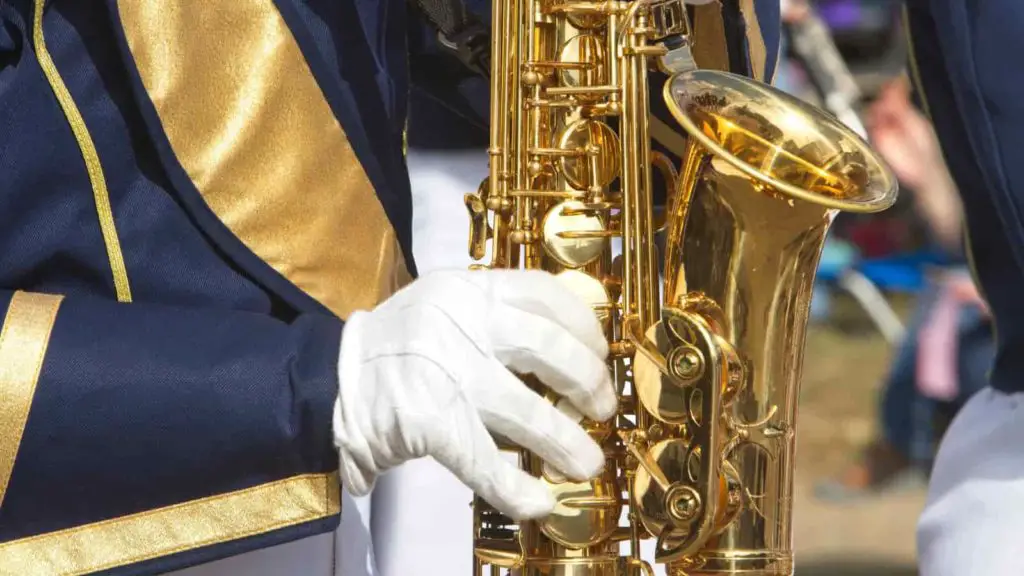
What are the Best Brands for Marching Band Saxophone?
The most popular and reliable brands of saxophones are Yamaha, Jupiter, and Selmer. Prelude by Conn-Selmer offers a more reasonably priced student instrument for a lower price, but you will still get a high-quality instrument.
Note: Check out this article to find out which brands to avoid: Ultimate Saxophone Buyers Guide
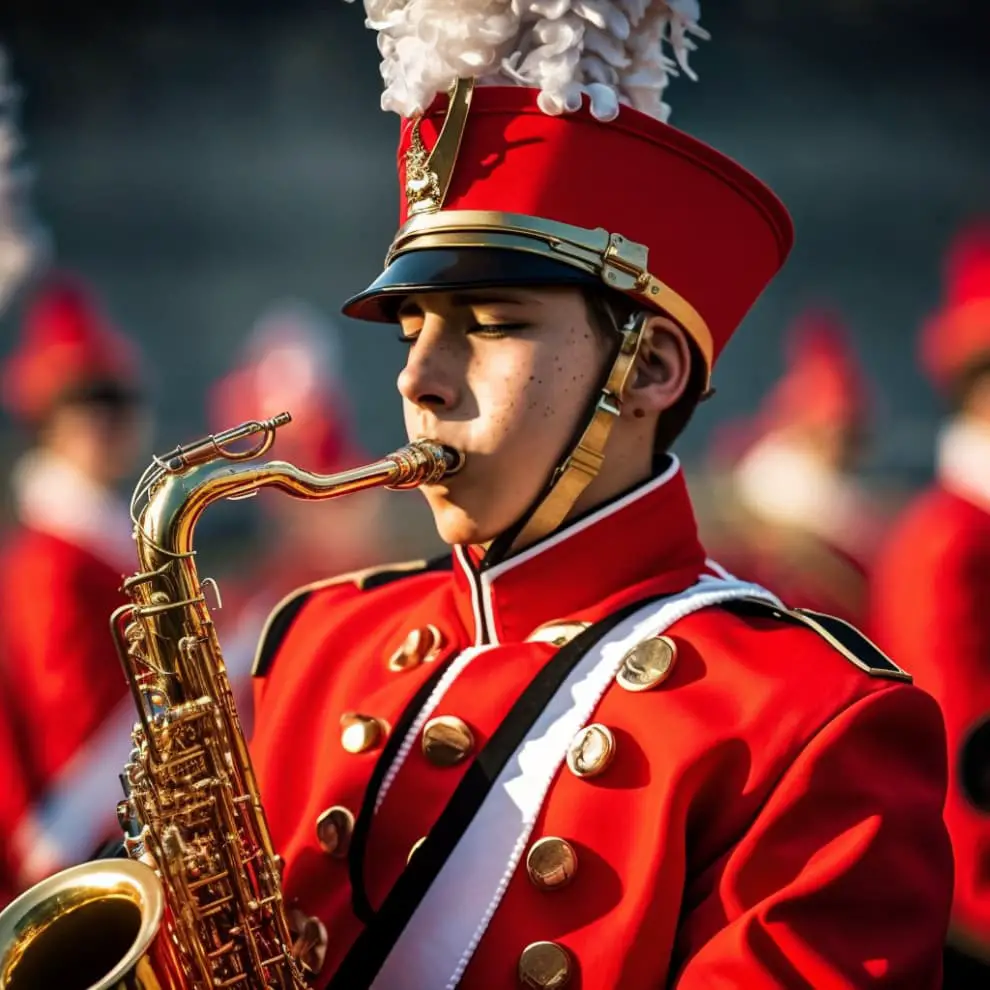
Yamaha
These instruments have a long-standing reputation for quality. You can’t go wrong when purchasing Yamaha instruments, including saxophones.
Possibly one of the only downsides is that the saxophones are such high quality you may not want to bring them outdoors for marching band unless you have an upgraded model.
Jupiter
These saxophones are also high-quality instruments commonly used in marching bands.
Depending on your location, they may be more difficult to purchase, but they are frequently available online and would make an excellent choice to play in a marching band.
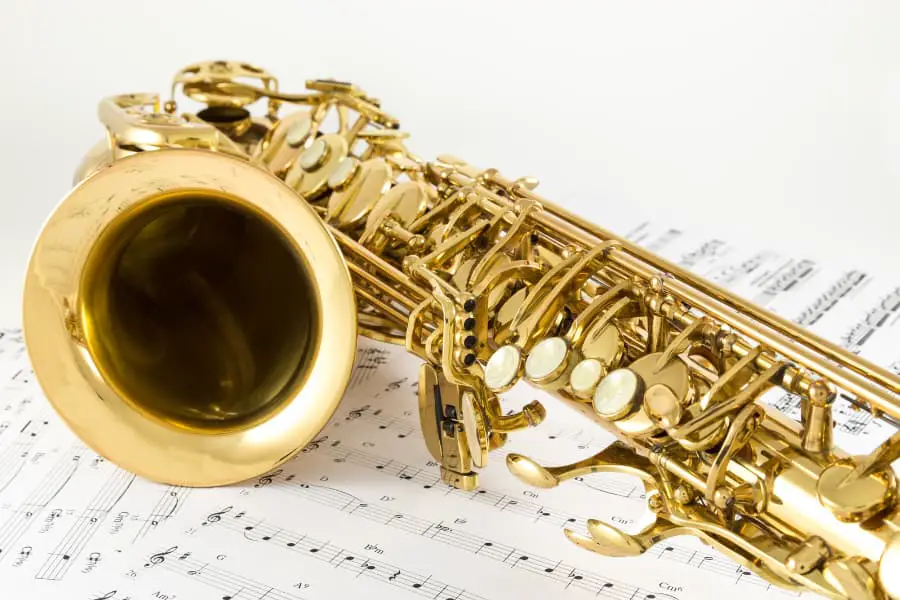
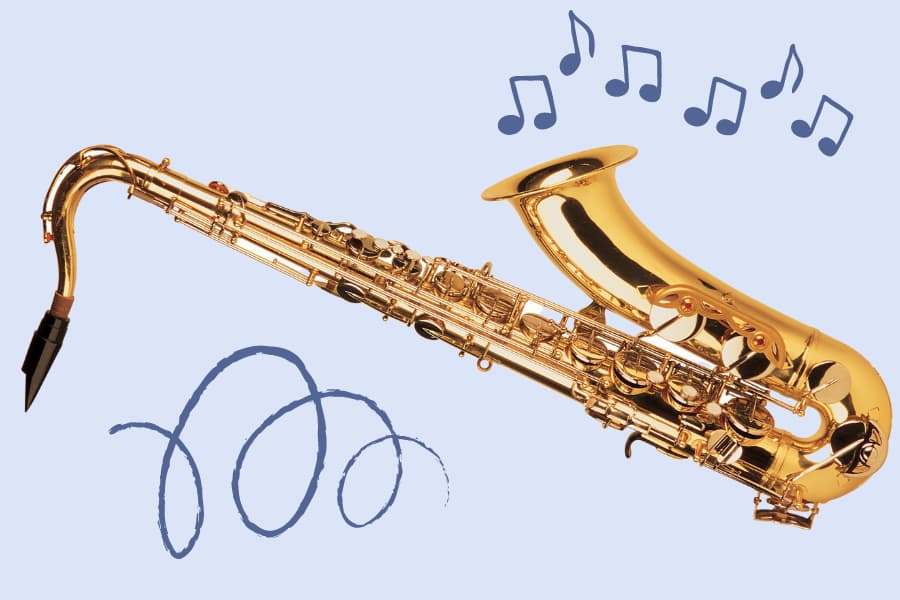
Selmer
Selmer saxophones are one of the most popular saxophones and can be played in any setting.
Like Yamaha instruments, they also make extremely high-quality professional models that you may not want to use in marching band.
Selmer also makes excellent saxophone upgrades, such as mouthpieces and ligatures.
Prelude by Conn-Selmer is an excellent compromise of quality and price since you get the long-standing reputation of Selmer in the more affordable Conn-Selmer student model.
You will not need to worry about bringing a professional-level instrument outside regularly, but will also not be concerned about the instrument holding up during long rehearsals. The alto version is the AS711 and the tenor version is the TS711.
Top Tip: Many brands now offer instruments at low price points, but using these instruments for marching band is not recommended as marching band instruments are used heavily outside in a variety of weather conditions. Saxophones under 500.00 will likely not hold up and will need regular repairs.
Allora
This brand does make generally reliable instruments that some band directors will advocate for if budgets do not allow for one of the above brands, but band directors typically agree unanimously to avoid other brands at even lower price points if at all possible.
While the price may seem excellent, these instruments are for casual hobbyists who are generally not interested in long-term investment into the instrument.
How to Rent a Saxophone for Marching Band
If you decide to rent an instrument to play in the marching band, Music and Arts offers a rent-to-own program where you can put installments toward owning the instrument but can turn it in if you stop playing. They also include maintenance and the possibility of upgrading instruments.
Other music stores in your area likely offer similar programs so it is worth looking up options near you. Your school may also have instruments available to use, but if not and you are interested in renting an instrument, one of the best, widely available options is Music and Arts. You can also look into financing an instrument through Amazon and pay for the instrument over time.
How to Hold a Saxophone in Marching Band
Additional factors that come into play when carrying a saxophone in a marching band are bringing instruments up and down.
Some bands decide to hold the instrument down at your side until bringing the saxophone neck up towards your face. Other bands decide to hold the saxophone out in front of your body parallel to the ground. Either way, holding the saxophone once it is up is generally going to be the same as indoor ensemble playing.
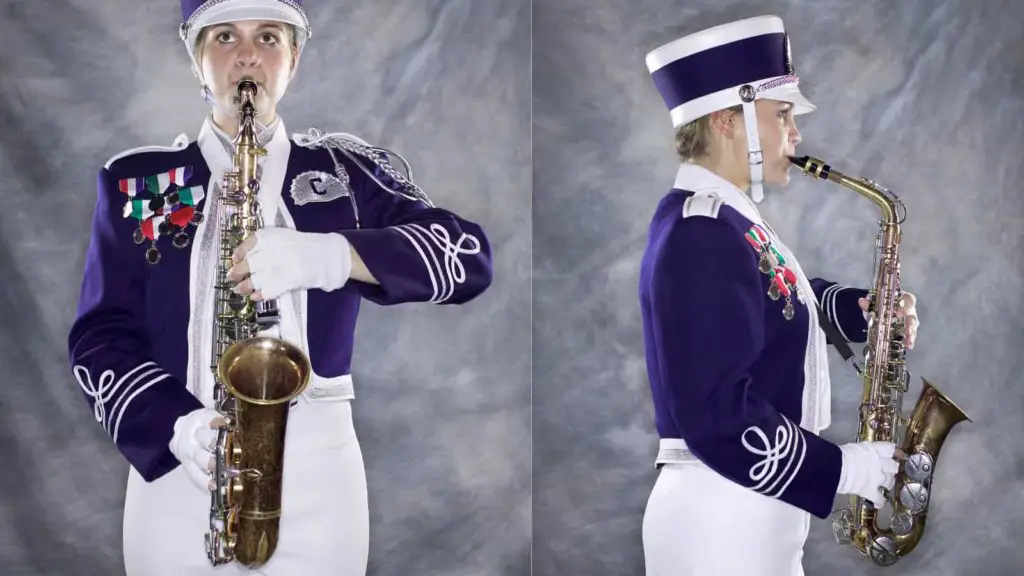
How Much Does a Marching Saxophone Cost?
As mentioned above, high-quality saxophones that you can rely on for marching band are typically going to be around $1,000 for a new instrument. Buying a used instrument, setting up payment plans, or renting might be better options depending on the situation.
Higher caliber instruments cost even more and may be better suited for indoor playing due to the long outdoor rehearsals, regular outdoor performances, physical components of marching band, and possible weather conditions. See the links above for recommendations on saxophones.
How Much Does a Marching Saxophone Weigh?
Alto saxophones are usually around 3-5 pounds, and tenor saxophones are usually around 6-8 pounds. Baritone saxophones are heavier at 11-20 pounds, and soprano saxophones are lighter at around 2 pounds.
Adding the case obviously increases the weight of the instrument, but saxophones generally are not too difficult to transport like other larger low brass instruments. The baritone saxophone is the exception, but cases usually have wheels to help make moving the case easier.
Best Neck Straps for Marching Saxophone
Common neck strap brands that work well for marching bands include Rico and Protec. Both offer comfortable support and stability at an affordable price. Neck-straps are particularly necessary in marching band due to marching and playing at the same time.
Pro-Tec makes a wide range of affordable neck straps and all work well. The ones with the clips or snaps compared to open hooks work better since the saxophone angle will change frequently during the marching band field show.
The saxophone neck strap by Rico has more padding, making it more comfortable to some. The neck strap is easily adjustable to fit the individual player. Once again, the snap hook is better than the metal hook since it completely closes off, making it more secure for marching bands.
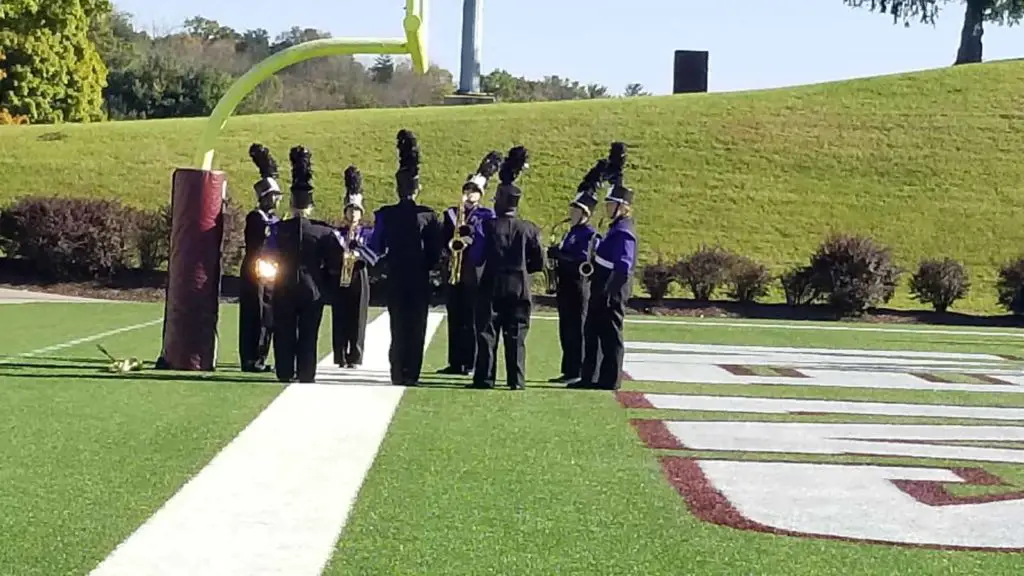
Do I need a new Saxophone Mouthpiece?
The mouthpiece that comes with your saxophone, or the mouthpiece you already have will work for marching band, but purchasing a new saxophone mouthpiece is the quickest way to upgrade and adjust your tone.
Top Tip: If you want to read in-depth about Sax Mouthpieces, check out this article.
One of the most common alto saxophone mouthpieces when starting off is the Yamaha 4C. It is great for beginners and will help you develop good habits on the saxophone.
If you already have a mouthpiece and want to upgrade, The Vandoren AL3 is an excellent choice. This mouthpiece will also sound great inside or carry into college playing.
The Selmer C* is another popular upgrade that has been used for many years. This mouthpiece will also work well through college; some argue these mouthpieces are more inconsistent, making Vandoren the better choice, but generally, these mouthpieces are still great.
All of these options will help you project your tone while still allowing you to blend with the rest of the ensemble.
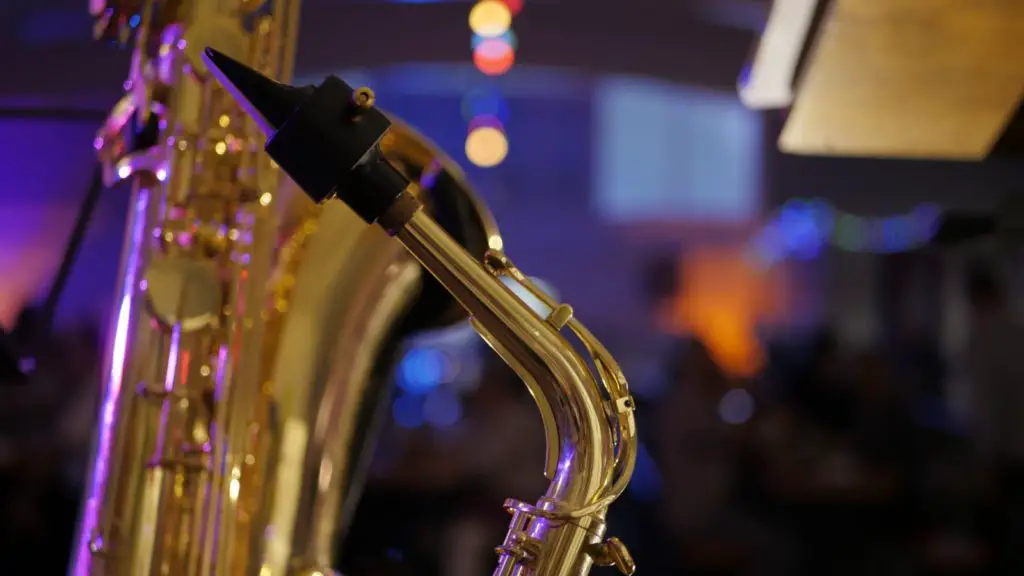
Jazz Mouthpieces for Saxophone
You may see information about jazz mouthpieces for saxophone. These mouthpieces are more open inside, helping more air travel through the mouthpiece and therefore making the tone louder. There is also a wider gap between the mouthpiece and the tip of the reed, giving the sound a brighter, edgier quality.
While this may seem like a good idea for playing in a marching band, in most situations, it will not be as good of an option since it will make it harder for saxophones to blend with the rest of the group. This is especially important if there are a lot of saxophones in the band and they need to blend together as a section. If some people are using jazz mouthpieces, and others are not, it will be challenging for the section to play with a unified sound.
Jazz mouthpieces would work well in jazz bands, or more contemporary styles like rock bands, pop music, hip hop, etc.
Top Tip: Check out these famous rock songs with saxophones in them. 15 Rock Bands With Saxophone Players (Past & Present)
What reeds should I use?
The most popular saxophone reeds are Vandoren Blue Box reeds. If you are new to playing, select a strength 2 or 2.5. The higher the number, the thicker the reed and the more difficult it is to play. Playing a reed under a 2 will result in a buzzy tone with less control over the sound.
Vandoren makes a wide range of reeds for saxophone. Their most popular reeds for marching band and concert band are their Blue Box reeds. Their V16 and Java reeds are used more in jazz settings.
Another option for reeds is Rico; they are cheaper but still work relatively well. Other brands that advertise significantly cheaper prices are risky as the quality will not be as good; playing will be very frustrating if reeds do not work well.
Up Next
Whether you are already a saxophone player, or entirely new to the instrument, we hope this article helped answer any questions you had about playing the saxophone in marching band!
Learn more about Marching Band by diving into these articles next.
Marching Band Questions Top 20 FAQ
Instruments in a Marching Band (How Many & What Kind)
Disclaimer: This post may contain affiliate links. We only recommend high-quality products that are used and recommended by real musicians. If you use these links to buy something we earn a small commission.
